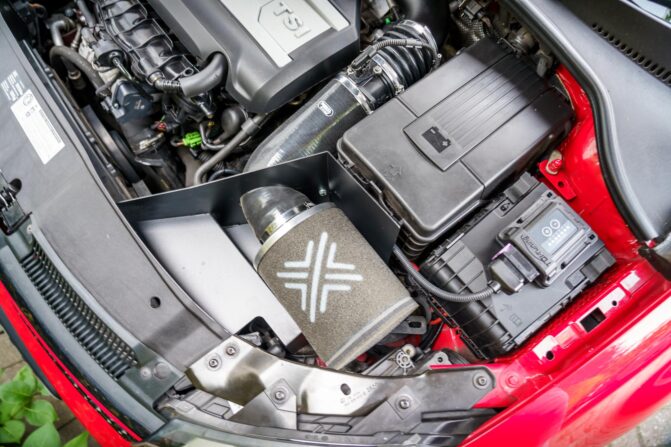The IAT sensor or Intake Air Temperature sensor is not something we talk about a lot. But it’s a very important part of your car’s intake system. Problems with it can cause running issues with your engine.
If you suspect you have a bad IAT sensor, we’ll discuss everything you need to know about it in this post. Use our table of contents to find the information you need:
What’s An IAT Sensor?
Before we proceed, in case you don’t have an understanding of how engines work, it works by combusting air (oxygen) and fuel inside of the cylinders. The more oxygen and fuel the engine burns, the more power it can get.
The Intake Air Temperature sensor, as the name suggests, measures the temperature of the air inside the engine’s intake system. The reason why it’s important is that air temperature affects air density and ultimately affects oxygen levels.
By knowing the air temperature, the Engine Control Unit (ECU) can determine how much fuel to put into the engine as well as manage other components crucial to the combustion such as the ignition.
Air is denser when it’s cold. Think of cold air as being thicker and higher in oxygen. So, when the engine takes in cold air, it takes in more oxygen. The ECU can inject the engine with more fuel to ensure a Stoichiometric air-to-fuel ratio (which is the ratio the engine will always aim to achieve) and you’ll get more power out of the combustion.
This is why cold air intakes are a popular upgrade choice. While effects are usually minimal, placing the intake further away from the engine allows it to draw in cold air. This results in more oxygen, and the engine can produce more power.
On the other hand, warm air is less dense and can hold more moisture. This results in less oxygen, and less power. The ECU can respond by reducing fuel or increasing air intake to compensate for the warm air.
Of course, other factors also affect how the ECU controls the engine. This includes throttle input, fuel quality, and engine temperature amongst others. The IAT is just one of many sensors that helps the engine operate smoothly.
IAT Sensor Location
The exact location varies depending on your car’s make and model. But since it has to measure air temperature before it gets into the engine, in general, you can find it somewhere along with the intake tubing. In some cases, it’s on the underside of the intake so you’ll need to take it off to find the sensor.
If you can’t find it around the intake tubing, in some cars it’s attached to the intake manifold. We recommend checking your service manual to find the exact location in your specific car make and model.
How Does It Work?
The IAT is a thermistor, so it responds to temperature changes just like a thermometer. When the air temperature changes, it will send voltage to the ECU so it knows what the intake air temperature is.
For example, if the air temperature is 100° F then it will send around 2 volts to the ECU to let it know. As the temperature increases, the voltage reduces—in some cases as low as 0.28 volts. And if the temperature increases, the volts get higher.
When the voltage from the IAT sensor is outside of the accepted value, this will tell the ECU that the IAT isn’t working properly. If the ECU can’t fix the issue by itself, it will register a Diagnostic Trouble Code (DTC) in the On-Board Diagnostic (OBD) system. This results in a check engine light, signaling to the driver that something is wrong.
Note that there are two types of IAT, and it may instead reduce the voltage when the temperature reduces. But more on that later. Also, The explanation above is a bit of an oversimplification, but the gist of it is that it works by sending voltage to signal air temperature.
IAT Sensor Symptoms
Since the IAT sensor affects how the ECU operates the engine, there will be noticeable symptoms when you have a bad sensor. Here are the symptoms you might experience:
1. Performance Issues
Performance issues from a bad IAT sensor can manifest in different ways. First, you may experience engine misfires and poor acceleration. This is when one or more of the cylinders aren’t firing, or aren’t firing at the correct timing.
Engine misfires usually feel like your engine is hesitating to accelerate when you press the gas pedal. Hence poorer performance. Note that misfires are different from engine backfire. A backfire is when combustion happens outside of the cylinder, and you’ll usually hear a popping noise from the engine.
The performance issues may also manifest in rough idling, which technically is also a sign of engine misfires. An engine RPM typically idles steadily at around 800rpm once it warms up. If you see the needle jumping up and down erratically, then your engine is idling rough.
These things can happen because the IAT isn’t giving the correct reading to the ECU. For example, the air temperature may be cold but the IAT is telling the ECU it’s warm. This leads to the ECU making wrong adjustments resulting in poor performance.
2. Difficulty Starting In Cold Conditions
Forget performance issues, your car may not start at all if you’re starting it in cold conditions with a bad IAT sensor. Again, the IAT may give the wrong temperature reading to the ECU which prevents the engine from starting smoothly.
For example, a cold engine typically needs more fuel to start the combustion process. Even more so when the air is cold. If the IAT tells the ECU that the air is warm when it’s actually cold, then ECU will reduce the amount of fuel since it thinks the air is warm and the engine won’t need as much fuel.
This results in difficulty starting since the engine isn’t getting enough fuel. The car will crank for quite some time, and probably takes a couple of tries—if it even can start. Note that other things can cause difficulty starting, read our guide to diagnosing a car that cranks but won’t start to learn more.
3. Poor Fuel Economy
In addition to performance issues, you may see poor fuel economy as well. Since the IAT is one of the sensors that the ECU uses to control fuel injection, a faulty sensor can affect ECU and fuel consumption negatively.
For example, if the IAT sensor is telling the engine that the air is cold even when it’s not, then the ECU may inject more fuel to maintain that Stoichiometric ratio. This isn’t necessary, since there’s less oxygen in warm air and the engine doesn’t need more fuel to balance it.
There are other scenarios as well, but the bottom line is that fuel consumption may be affected negatively. Note that the effect may be minimal, and you might not notice it, especially if your car doesn’t have a fuel consumption monitor.
4. EGR Valve Issues
The EGR valve or Exhaust Gas Recirculation valve is an emissions control device that recirculates some of the exhaust gases back into the engine. This valve opens depending on the conditions. But the idea is that it recirculates the exhaust gas to be burned again in the engine; reducing emissions and increasing fuel consumption.
The EGR opens and closes on the ECU’s demand, so it works indirectly with the IAT. If the IAT gives false reading to the ECU, it can affect the EGR’s operation and it might not open when necessary.
You’re not going to notice this apart from changes in the fuel consumption, since the EGR valve isn’t a device that you directly interact with. But EGR issues will throw a trouble code and can trigger a check engine light. This brings us to our next and final symptom:
5. Check Engine Light
Finally, we get to that dreaded amber-colored check engine light. Since it’s an electrical component, the OBD system can throw trouble codes when it detects something wrong with the sensor. And when it registers a trouble code, it will trigger the check engine light.
Thankfully, this makes diagnosing your car a lot easier. Especially if you have an OBD-2 system, which is virtually every car since 1996. If your car has an OBD-1 system, you’ll need to research further how to diagnose in your specific car make. The system is proprietary, so it differs from one car make to another.
Meanwhile, the OBD-2 system is universal. So, any OBD-2 scan tool will work with any car that has an OBD-2 system regardless of the car brand. Here’s how to use an OBD-2 scan tool:
A problem with the IAT sensor will usually trigger one or more of the following codes:
- P0111 – Intake Air Temperature (IAT) Sensor 1 Circuit Malfunction.
- P0112 – Intake Air Temperature (IAT) Circuit Low Input.
- P0113 – Intake Air Temperature (IAT) Sensor Circuit High Input.
All of these trouble codes indicate that IAT is giving erratic readings to ECU (similar to the P0113 Dodge code). This could mean it’s faulty, or the sensor is dirty and needs a cleaning. This segues us nicely to our next section:
IAT Sensor Fault Causes And Diagnosis
Like any electrical device, the sensor may fail over time due to age. Most manufacturers will say it’ll last for around five years, but it can last longer or shorter than that.
The sensor may also send false readings to the ECU due to dirt. If the sensor is covered in dirt, it may send the wrong signals to the ECU. This can happen because the air isn’t always clean, or maybe you have a dirty air intake filter—which you should change at least every 12,000 miles by the way.
Anyway, if you have one of the IAT trouble codes we mentioned above, we recommend inspecting it further. Cleaning it first and then testing it to see if it works:
IAT Sensor Cleaning
Testing the IAT requires you to take it out of the engine. And before testing it, it’s a good idea to clean it first as a dirty IAT sensor may return bad testing results anyway. As mentioned, the exact location of the IAT sensor varies depending on your car’s make and model.
Once you locate it, disconnect the car’s battery first. Afterward, removing it is usually just a matter of disconnecting the electrical connection, and then pulling the sensor out of its slot. Although some cars may require you to unscrew them with a socket wrench, and even remove the air intake tube altogether. Here’s an example in Ford’s EcoBoost engine:
Once you get it out, then spray it with a cleaning solution. A Mass Airflow sensor or MAF cleaner is preferable. Spray it in the open air and from a good distance, and DO NOT wipe it down or use a brush to clean it.
Simply spray the cleaning solution, around 10-15 sprays if necessary. Then let the solution evaporate from the sensor. Once it seems clean, you have two options:
You can reinstall it back into the engine, then reset the check engine light (such as how you’d reset a BMW check engine light). This clears the trouble code and gets rid of the check engine light. Drive the car for a few minutes, and if the light and code don’t return, then your IAT is now working fine.
However, if the light returns, you’ll need to scan the OBD system once again and check the trouble codes. If it’s still throwing the IAT trouble codes, then the IAT may be faulty. At this point, you can either take it out and test it or replace it. Here’s how to test the IAT:
IAT Electrical Connection Test
There are two things you’ll need to test: the IAT sensor itself and its electrical connector. To test the electrical connector, here’s what you need to do:
- Take a digital multimeter, and connect the negative (black) lead to the engine’s ground (any metal point in the car).
- Set the multimeter to 200VDC, then turn the ignition on. No need to start the car.
- Connect the positive (red) lead to connection number 1 in the IAT’s electrical connector, this is usually on the left side. It should read around 5 volts.
- Next, set the multimeter to the continuity setting.
- With the negative lead connected to the engine ground, connect the positive lead to the second connection. If the multimeter beeps, then the connector is good.
IAT Sensor Testing
Once we verified that the electrical connection is fine, let’s check the IAT sensor itself. You’ll need a multimeter, alligator clips for the leads, and a hairdryer.
You’ll also need to verify whether you have a positive or negative IAT sensor. A positive sensor means the voltage increases as the temperature increases, and it’s the opposite for the negative sensor. Check your service manual to be sure. Afterward, here’s how to test it:
- Connect the alligator clip to the multimeter’s negative lead. You can do this for the positive lead but it’s optional.
- Set the multimeter to the 200k Ohm setting.
- Once the positive lead is also connected, you’ll get a voltage reading on the multimeter. If the room temperature is around 86° F, it should read around 3.06 volts.
- Afterward, blow hot air with the hairdryer to the sensor. Don’t blow too close to avoid damage.
- The voltage reading should change. If it’s a positive type, then the voltage will increase. Meanwhile, the negative type will drop its voltage.
You can also use the method shown above by dipping the sensor in warm water, any method works fine as long as you know which type of IAT sensor you have in your car.
If the voltage doesn’t change with the temperature, then the sensor is no longer working correctly and you’ll need to replace it. This brings us to:
IAT Sensor Repairs & Costs
If you have difficulties diagnosing the issue, we recommend taking your car to a trusted mechanic and letting them do it. A simple diagnostic process should cost around $120 for most cars.
Replacing the IAT should cost no more than $110 in most cars. The sensor itself is usually between $40 and $60. Meanwhile, labor is usually around $50 since the part is quite easy to replace.
However, if your car’s IAT sensor is a bit difficult to access, then labor might cost a bit more than that. Most shops will usually charge by the hour, and that’s usually about $90. On average, it’s no more than $110, but special cases can cost up to $150.
If it turns out you have bad wiring, then wiring repairs are usually around $200 – $300. This is a rough estimate and may be lower or higher, it’s hard to say how much it will cost as wiring repairs varies greatly.
Also, we recommend leaving wiring repairs to professionals. They’re generally more difficult to do, especially if you have no experience or background in electrical engineering. But if you just need to replace the IAT, you can do it yourself:
IAT Sensor DIY Replacement
Replacing the sensor is fairly straightforward:
- Disconnect the car’s battery.
- Locate the IAT sensor location in your car.
- Disconnect the sensor’s electrical connection, and remove the sensor. Some cars have the sensor on the underside of the intake tube, which means you’ll need to take it out. Or near the intake manifold, and you’ll need to remove the engine’s plastic cover.
- Take out the old IAT sensor, you may need to twist it or use a wrench to remove it.
- Install the new sensor, and make sure to align it properly just like the original sensor.
- Reinstall other components if you had to remove them to gain access to the sensor, and reconnect the battery.
- Reset the check engine light to get rid of the trouble codes, take a drive and you should be good to go.
The video above from 1A Auto shows how to do it in a 2015 Jeep Wrangler. Again, the location varies depending on your car’s make and model. But the steps are similar and fairly easy to do. Good luck!
Intake-Air Temperature Sensor: Facts
- The intake-air temperature sensor provides the engine control unit with important measurements for correcting mixture formation and ignition.
- Faulty symptoms of the intake-air temperature sensor can include engine indicator lamp coming on, problems starting, reduced engine power, and increased fuel consumption.
- Causes of a faulty intake-air temperature sensor can be internal short circuits, breaks in wiring, wiring short circuit, mechanical damage, or dirty sensor tip.
- Checking the intake-air temperature sensor involves reading out the fault memory, checking the electrical connections, and carrying out tests with a multimeter.
- The resistance of the temperature sensor changes depending on the intake-air temperature, which the control unit evaluates.
- The voltage values from the sensor are directly related to the intake-air temperature, where low temperatures result in high voltage values and high temperatures result in low voltage values.
- The information provided on the website is intended for use by suitably qualified personnel only.
- The special reference value specifications must be noted when carrying out the tests.
- The functional principle of the intake-air temperature sensor determines the temperature in the suction pipe and forwards voltage signals arising from the temperature to the control unit.
- If the voltage value is not reached when checking the supply voltage, the voltage supply of the control unit and the ground supply must be checked according to the circuit diagram, and a control unit fault comes into question if these are okay.
IAT Sensor FAQ
Your questions answered:
What Is A IAT Sensor
The IAT or Intake Air Temperature sensor is the sensor inside your car’s intake system that measures the air temperature inside the intake system. The ECU needs to know the temperature to estimate the oxygen the engine is getting so it can adjust the operation of other engine components accordingly.
What Does IAT Sensor Do
The IAT works with multiple other sensors and the Engine Control Unit (ECU) to ensure the smooth operation of the engine. It measures air temperature in the intake system, which is important since temperature affects the amount of oxygen the engine is getting. The ECU takes this information along with information from other sensors to adjust engine settings accordingly.
Where Is The IAT Sensor Located
The IAT usually attaches to the air intake tube or near the intake manifold. In the case of the latter, you’ll often need to remove the engine’s plastic cover to access it. But it can also be located on the underside of the intake tube, in which case you’ll need to remove the tube from the engine to gain access.
How To Test An IAT Sensor
You can test the IAT sensor by using a multimeter and with the help of a hairdryer. Connect the multimeter to the IAT’s connection, and you should get a voltage reading. Then blow hot air with the hairdryer, but not too close to avoid damage. The change in air temperature should change the voltage reading (it could drop or rise depending on the IAT type). If the readings don’t change, or it’s outside the pre-determined value, then the IAT sensor has gone bad.
Is IAT Sensor Same As MAF Sensor
No, these are different sensors. The IAT measures intake air temperature, while the MAF (Mass Airflow) measures the airflow rate inside the intake system.
Can I Run My Car Without An IAT Sensor
No, you can’t. The IAT sensor helps the ECU to know how to adjust engine settings accordingly and keeps the engine running smoothly. Driving without an IAT sensor or with a bad one can cause engine damage in the long run.
IAT Sensor: Wrap Up
To summarize, the IAT or Intake Air Temperature sensor measures the air temperature inside the engine’s air intake system. This is necessary because air density and oxygen level change depending on the air temperature.
Cold air means the air is denser, and it’s likely to have more oxygen for your engine to burn. Meanwhile, warmer air is less dense and will usually provide less oxygen for the engine.
The ECU then takes this information along with information from other sensors to adjust the engine operation accordingly. It can control fuel injection, ignition timing, and EGR valve operation amongst others. And knowing the intake air temperature can help ensure smooth operation.
The IAT sensor can go bad after about five years, or it can get dirty and won’t work properly. They usually cost no more than $110 to replace including labor. The part itself is usually around $60 and you can do it yourself as it’s quite an easy job to do. Hopefully, this has been helpful for you, and good luck!





